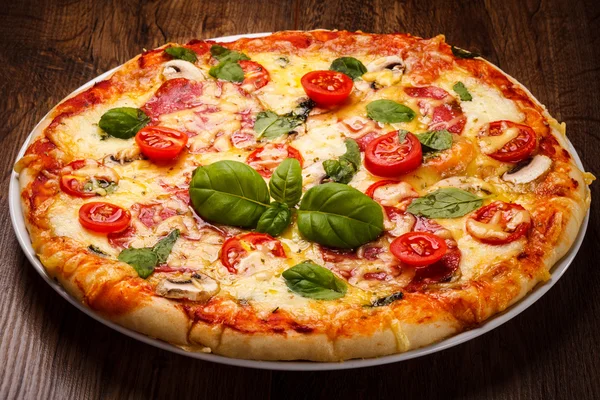In 2016, I had my inaugural pizza encounter, savoring a leftover slice from my girlfriend’s outing with a ‘Big Man’ in this republic.
Upon receiving my first salary in 2017, I celebrated by treating myself to a medium-sized Pepperoni pizza and a litre of Coca-Cola.
At the time, the taste wasn’t my focus; I was driven by a desire to rectify a perceived gap in my life experiences and mark a new chapter: A Pizza one.
It became a coveted monthly indulgence, typically reserved for Fridays or Sundays. I eagerly looked forward to savoring it with a cold beer or coke, to pamper myself. However, the desire for pizza is one thing, and being able to afford it in a country like Ghana where it’s considered a luxury can be a challenge.
Pizza is a beautiful delicacy. I often liken a good pizza to sex. The possibilities are endless with a diverse range of toppings available, making it a specialized and versatile “culinary” delight.
Initially, I felt awkward making the connection, but if we are to consider pizza as a cultural and historical entity, it exudes various themes like family bonds, Mother’s Day, community, employment opportunities, love, convenience, even immigration and more.
Every pizza-loving human can connect something intimate to pizza! Pizza can be enjoyed alone but it’s more fun sharing with others and that’s the inspiration behind its round shape.
Pizza is generally healthy but healthy is subjective and that may depend on what the consumer does with it. For anyone checking for nutritional values, pizza is a healthier option compared to noodles and shawarma. Pizza’s versatility makes it a perfect side to most meals whether it’s breakfast, lunch, or dinner. It can be enjoyed on its own, either hot or cold. I deliberately save leftovers sometimes to indulge in cold pizza for breakfast, paired with cups of hot cocoa – a taste of both worlds!
Since its commercial introduction in Accra in the 2000s, the love for pizza has spread throughout Ghana, with numerous establishments adding it to their menus to stay competitive.
Pizzas have become a romantic gesture for young men to show their affection on dates. It’s the minimum expectation for many women in relationships on special occasions like birthdays, Valentine’s Day, and Christmas in Ghana. You can enhance the gesture by adding wine, coke, or other accompaniments, or make the pizza a complement to a larger gift. Either way, it’s a winning move for the relationship.
Pizza Nights are now a big highlight of Accra’s evening gatherings. They’ve become a super fun tradition that brings together people from all corners of the city. From university students to charismatic fellowship meetings and corporate team-building events, pizza has become the centre of these casual get-togethers. The atmosphere is mostly relaxed, with music, fun games, and a variety of food. While the free food and drinks in some cases are a big draw, the real allure lies in the overall experience and the sense of belonging that comes with it.
Mother’s Day 2024 was extra special at Makola market thanks to The Happy Town Project and Pizza Inn’s collaborative efforts. The NGO, dedicated to spreading joy, joined forces with the popular pizza chain to treat hard working mothers at Makola Market to a delightful pizza experience. The result? A day filled with happiness, and appreciation. This unique initiative emphasized the special touch pizza brings to this global celebration, redefining the way we show love and appreciation to women on Mother’s Day in Ghana. Pizza has become a thoughtful gesture that speaks straight to the heart of loved ones.
Football is a passion that runs deep in Ghana, and despite the Black Stars’ inconsistent performances, Ghanaians still celebrate whenever the team gets a victory. This fervor extends to their favorite European teams, with fans reveling in every win. Interestingly, pizza is becoming an integral part of the football experience in Ghana, whether it’s virtual FIFA games or real-life matches. When fans gather to watch their favorite teams, pizza is now a feature on the menu!
While some people have perfected their recipes, others struggle to master the fundamentals. In this short time, I’ve sampled a few pizzas; from exceptional ones reminiscent of Chicago-style deep dish to barely passable ones with some resembling nothing more than repackaged local tea bread.
The majority of pizzas on the market suffer from an imbalance in the bread-to-topping ratio, with excessive bread and insufficient flavor. The crust often lacks a crispy golden brown texture, instead, resembling burnt local bread. The tomato sauce has an unpleasant sweetness and the low-quality cheese, though abundant, falls short on flavor and texture. At times, it’s preferable to opt for freshly baked oven bread and forego the disappointment.
What really makes a great pizza, and what ruins it?
For Esinam Osei of The Good Food Company, a great pizza is about using and baking with quality tools and products. The dough has to be good and you have to use olive oil for the dough and the toppings as well.
“The thing with baking is that, when you use premium stuff you get good quality. So the toppings have to be very good, use fresh vegetables and herbs like oregano, and of course, you should be someone who knows what they’re doing and the cheese should be very quality mozzarella cheese,” she said.
Chef Nuva, a culinary expert in Accra emphasizes the importance of three critical components for making a great pizza:
First, the sauce: a rich, creamy texture and a balanced flavor profile are essential, with subtle notes of garlic, parsley, and a hint of sweetness in tomato-based sauces.
Second, the cheese: High-quality cheese is vital, offering a flavorful taste, optimal elasticity, and a melt that showcases its excellence.
Third, the dough: A well-crafted crust is crucial, with a mix that yields an airy yet sturdy texture, avoiding dryness and excessive chewiness, providing a solid foundation for the pizza. Prioritizing these three elements, you’ll be on the path to crafting a truly exceptional pizza.
A chef at Pizza Hut strongly believes the trick to a great pizza is the toppings.
”It’s possible to miss a few things in the process, but that doesn’t have to spell doom for your pizza if you can get the toppings on point”, she said.
At Roundabout Pizza in Spintex, Chef Charles Banini stresses that a great sauce is vital for a great pizza. He insists on chopping the tomatoes, garlic, and onions, rather than blending them. “Blending it makes it like a stew.” he said.
With a smile, he emphasizes the importance of balanced sugar and salt additions. When asked about common pizza mistakes, his expression turns stern as he warns against using canned or tin tomatoes, stressing the need for fresh vegetables to achieve good quality.
His facial expressions got my attention more; he took it personally- the expressions underscored his strong conviction that canned tomatoes really ruined pizza quality. Chef Charles also notes the importance of ingredient balance, as excessive toppings can overwhelm a light dough. Finally, he argues a thin or puffy crust is a consumer’s preference not necessarily a procedure.
While making a great pizza appears straightforward, the truth is, there’s no one-size-fits-all formula for achieving perfection as the ideal taste is subjective. However, despite the creative freedom and potential for happy accidents, consistency is the secret ingredient, repeating the exact techniques and ingredients defines the quality and flavor of your pizza.
As pizza’s popularity reaches its peak and stabilizes, it will transition from a high-end treat or luxury to a commonplace favorite, similar to the trajectory of fried rice (Check-Check). Ultimately, it will become an integral and accepted element of our cultural identity, losing its exclusive status and becoming a normalised element of our collective culinary identity. Indeed, this transformation is already underway with some local eateries and individual endeavors making some seemingly unconventional efforts to get a perfect recipe.
I look forward to the day when pizza will become a standard option in the national school feeding program for students. I am convinced that pizza can enrich the learning experience, serving as a connection to diverse cultures and fostering a more inclusive educational environment.
Now imagine that.
















